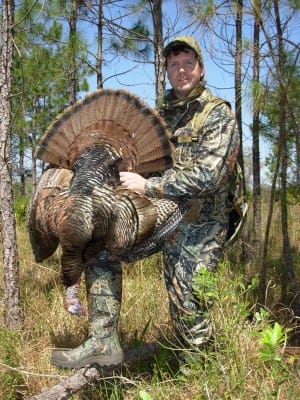 Like a child awaits Christmas, the turkey hunter dreams about the opening day of hunting season. Impatiently counting the days as that magic time draws near, it is no wonder most hunters are so optimistic as the season approaches. And why not? That first day promises the only day a hunter can guarantee that the bird he’s going after hasn’t been pressured by other sportsmen working calls and shooting guns.
Like a child awaits Christmas, the turkey hunter dreams about the opening day of hunting season. Impatiently counting the days as that magic time draws near, it is no wonder most hunters are so optimistic as the season approaches. And why not? That first day promises the only day a hunter can guarantee that the bird he’s going after hasn’t been pressured by other sportsmen working calls and shooting guns.
It’s the best day to catch one on its day-to-day routine before people, trucks and ATVs moving about and excessive calls and shotguns ringing out force it to maybe gobble a little less and come to the sound of a hen’s yelp a little more cautiously.
Thus loaded with optimism and a magazine full of No. 5s, every turkey hunter will watch as that first sun rises to mark the start of a new turkey season and on that day every one will expect nothing less than to fill their tag. While some hunters will get lucky and stumble on to a hot tom, many others will blow their opportunity by not being as prepared as they should. I don’t want to fall in either camp.
On opening day, I want to hit the ground with a game plan and know exactly where the birds are that I plan to hunt. And when I finally squeeze that trigger and stroll over to admire my trophy, I will know it was because I was prepared. Here are five tips on how to make sure you’re prepared as well.
1. Scout the Right Time
Diehard sportsmen dedicated enough or simply able to stop by their hunting land on a near daily basis weeks and even months before the season starts will argue with me here, but I don’t like to waste much time scouting until a mere week or two before the season starts. Sure, I’ll cruise by a field now and then to glass a feeding flock, but I don’t get methodical about it until just before the season is about to begin. Flock patterns and makeup are changing by the week and even day at this time of the season as gobblers begin to pursue hens in anticipation of breeding. Birds will roost in different areas and those big gangs of gobblers you saw in January will be splitting apart. For that reason, it makes little sense to scout out a situation that will most likely change before I’m actually hunting.
2. The Right Way to Scout
When you do finally get out there to scout, make it count. Get to your hunting property before dark, sit back and listen. Get to a good spot like an open hardwood ridge or hilltop meadow, even a large field edge, where you can hear a good distance on a clear morning. Listen for and pinpoint gobbling birds and then determine where they go after flying down by glassing fields and listening for calling throughout the morning.
You want to identify several different huntable birds as options for your first day of the season, particularly those birds that are in deep pockets of your property if you share it with other hunters as they will be less apt to go after the hard-to-get-to gobblers. During midmorning, keep to the shadows of the forest and glass, glass, glass open fields. I approach this like I do big game scouting and want a good pair of optics to ease eye strain and really allow me to peer into distant shadows for lounging toms. I like my full-size Nikon Monarch 8.5x45s for this task as the glass is crystal clear and the ergonomics of each barrel makes for comfortable extended sessions of glassing.

3. Perform a Gear Check
Nothing is worse than getting ready to head out that first morning of hunting and not being able to find a crucial piece of gear. In some cases, it could mean the difference of success or failure. Make a list of everything you want or need to carry with you that first morning and then run a little inventory on it. Make sure you can put your hands on your camo, boots, turkey vest, rain gear, shotgun shells, optics, calls, ratchet cutters, face mask, gloves, hats, decoys, GPS or compass and anything else you will need. This even includes your shotgun or bow. One time I was hunting with several other guys and we got all the way out to where we were going to hunt for the day and the one guy realized he had left his bow back at camp.
4. Run Those Calls
Several years back, football great Peyton Manning was recovering from an off-season injury and missed the preseason, but started the opening game. Even the great Peyton Manning played that game, and the next few, pretty darn mediocre. My point? Peyton needs to practice, so should you.
First make sure all of your old calls are in good working order and replace those that aren’t. Check mouth calls to make sure they’re not dried out and rinse them in a diluted solution of mouthwash to kill any germs before using. Tune box calls by adjusting the screw on the lid to get the right pitch. Be sure to chalk them and then run them a bit. Practice a little every day-even before you begin scouting. You can’t expect to show up the first morning of the season and grab a call the first time and make it sing. In fact, making the wrong sound, could send your one opportunity at a shot, walking the other direction.
5. Know Where Your Gun Shoots
Most guys hang a piece of paper against a backstop at 40 yards, toss a load of No. 5s or 6s downrange at it, see that a bunch of the pellets covered the paper and then figure they’re ready for a live bird. Some don’t even do that.
Maybe that guy’s ready and maybe he isn’t. The fact is, turkeys don’t always stand there broadside in the open at that perfect 25 to 35 yards. More often than not you’re shooting at them while you’re twisted at an awkward angle, they’re partially obscured by brush or tall grass or they may even be standing a mere 10 yards away, in which case your payload is going to need to be delivered with rifle-like accuracy since the pattern will not have barely begun to spread out yet. Buy a box or two of the loads you plan to use and go out and shoot them while dressed in the same clothes you’ll be hunting in-facemask, gloves, the whole works. Shoot at targets through the woods, down a hill, up a hill, into the sunlight, from six feet away, even 50 yards away. The goal is to mimic as many of the actual scenarios that you might encounter in the outdoors. That way when you do run into a tom that presents a shot like that, you’ll be completely confident in taking it or you’ll know you need to hold off.
Follow these tactics of preparation and you’ll be ready come opening day, no matter what the woods and the turkeys throw at you.







